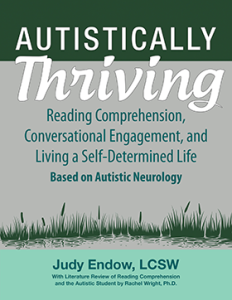I am a speaking autistic woman. Even so, I rarely have fluid access to my speech. Often times I have in mind something I would like to discuss with a friend so as to get their thoughts and ideas on the topic, but even though I know what I want to discuss the words are not available as speaking words. Oh, I know the words – they are in my head – I just cannot get them to come out of my mouth at will.
This often poses difficulties for me. One example is when I am with my friends who I consider to be brilliant in the field of autism. Most of the time I am with them for a purpose so we have an already planned agenda with little time for novel thoughts and musings sorts of discussions. We are all busy people in our professional and in our personal lives. Rarely is there time to get together for no reason at all – the times when I am most able to get the ideas in my head out through my mouth in speaking words.
Because I talk – and I can talk a lot – people who do not know me well are unaware of this difficulty.
People can easily see movement difficulties that are physical such as when a person has difficulty getting through a doorway or get stuck in a repetitive movement. However, nobody can see when the movement difficulty is internal such as words that cannot come out as speaking words at the time you wish to say them (Endow, 2013).
Over the years I have come up with several strategies to encourage the speaking words out of my head. The reason I need several strategies to try is that I never know which one might work when and sometimes, even though I try all the strategies, I still have no success. Here are the three main strategies that sometimes work for me to get the ideas in my head to come out as speaking words:
- Begin speaking any words. Sometimes this allows the words I really want to speak to hook onto the random words and thus be carried out of my head through my mouth as spoken words. When the strategy doesn’t work at least I get credit for “being social” – an area I can easily get “down graded” in if not putting forth effort.
- Use a research article that has some aspect I can use as a launching pad. Some- times if I can start speaking about a research article related to my thoughts, the ideas in my head can hook onto this with corresponding words coming out of my mouth. When the strategy doesn’t work at least the conversation was about some new and interesting research.
- Use written words. Sometimes if I write down the words I wish to speak, then, when I am with the person I want to have the conversation with, I can pop up the picture of the piece of paper I wrote the words on and by seeing this in my head I am able to “read” the words as a launching into the conversation I wish to initiate. When the strategy doesn’t work nobody can tell because they cannot see the picture in my head so I do not get “faulted” socially.
I wrote about this last strategy more than twenty years ago. It was first published as a poem in my first book Making Lemonade: Hints for Autism’s Helpers (Endow, 2006). A few years later this one written poem became the catalyst that allowed the words of an entire new book called Paper Words: Discovering and Living With My Autism (Endow, 2009b) to be written. Here is that poem. Notice the unusual spacing. The empty spaces represent the pause in time it takes, even when writing, for the next word to come in so I might write it down. As you read please contemplate how internal movement differences might impact autistic individuals you know.
Paper Words
Paper words
can be heard
so speak up ink
and say them!
Speaking words
are burdensome;
they get her
lost and tangled.
When speaking words
two people should
take their turns
to say them.
Start words now
then stop and wait
and listen some
adds up to conversation.
But, starting words
and stopping them;
and seeing faces
is much too much
to keep track of
when having conversation.
So, paper words
are much preferred.
Speak up ink;
now say them!
Listen people
to the ink;
you won’t get
lost or tangled!
NOTE: This selection comes from the book Autistically Thriving: Reading Comprehension, Conversational Engagement, and Living a Self-Determined Life Based on Autistic Neurology.

BOOKS BY JUDY ENDOW
Endow, J. (2019). Autistically Thriving: Reading Comprehension, Conversational Engagement, and Living a Self-Determined Life Based on Autistic Neurology. Lancaster, PA: Judy Endow.
Endow, J. (2012). Learning the Hidden Curriculum: The Odyssey of One Autistic Adult. Shawnee Mission, KS: AAPC Publishing.
Endow, J. (2006). Making Lemonade: Hints for Autism’s Helpers. Cambridge, WI: CBR Press.
Endow, J. (2013). Painted Words: Aspects of Autism Translated. Cambridge, WI: CBR Press.
Endow, J. (2009). Paper Words: Discovering and Living With My Autism. Shawnee Mission, KS: AAPC Publishing.
Endow, J. (2009) . Outsmarting Explosive Behavior: A Visual System of Support and Intervention for Individuals With Autism Spectrum Disorders. Shawnee Mission, KS: AAPC Publishing.
Endow, J. (2010). Practical Solutions for Stabilizing Students With Classic Autism to Be Ready to Learn: Getting to Go. Shawnee Mission, KS: AAPC Publishing.
Myles, B. S., Endow, J., & Mayfield, M. (2013). The Hidden Curriculum of Getting and Keeping a Job: Navigating the Social Landscape of Employment. Shawnee Mission, KS: AAPC Publishing.

